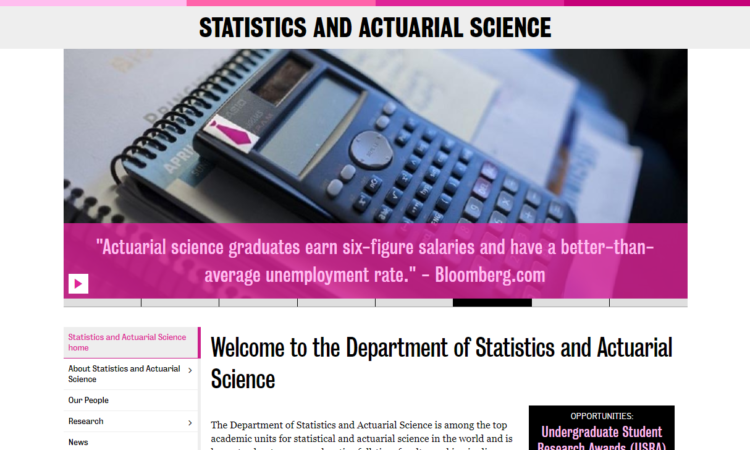Programs
- Bachelor's Degree
- Master's Degree
Actuarial Science Program
The University of Waterloo is located in Waterloo, Ontario Canada which is approximately 60 miles (100 km) from Toronto International Airport.
The Actuarial Science Program, at the University of Waterloo, is available in either a regular program or co-op stream. The Canadian Institute of Actuaries has accredited Waterloo’s Actuarial Science program and because of this accreditation students can be exempted from several of the Institutes exams.
Students who plan to pursue a career in the Actuarial field will apply to the University of Waterloo’s Mathematics degree program. At the end of their first year, student should choose Actuarial Science as their major.
Core Business Requirements
All Actuarial Science students must complete the programs core business curriculum. These core business courses consist of the following:
- Financial Accounting
- Economics
- Math
- Statistics
- Computer Science
Core Math Requirements
University of Waterloo Actuarial Science students will begin their studies with the following courses with will provide them with the mathematical base to continue with their actuary degree:
Calculus I
Absolute values and inequalities. Sequences and their limits. Introduction to series. Limits of functions and continuity. The Intermediate Value theorem and approximate solutions to equations. Derivatives, linear approximation, and Newton’s method. The Mean Value theorem and error bounds. Applications of the Mean Value theorem, Taylor polynomials, and Taylor’s theorem, Big-O notation. Suitable topics are illustrated using computer software.
Calculus II
Introduction to the Riemann integral and approximations. Antiderivatives and the Fundamental theorem of calculus. Change of variables, Methods of integration. Applications of the integral. Improper integrals. Linear and separable differential equations and applications. Tests for convergence for series. Binomial series, Functions defined as power series and Taylor series. Vector (parametric) curves in R2. Suitable topics are illustrated using computer software.
Algebra
An introduction to the language of mathematics and proof techniques through a study of the basic algebraic systems of mathematics: the integers, the integers modulo n, the rational numbers, the real numbers, the complex numbers and polynomials.
Some Core Actuarial Science Requirements
Life Contingencies
The future lifetime random variable: probability and survival functions; force of mortality; complete and curtate expectation of life; Makeham and Gompertz mortality laws. Life tables: characteristics of population and insurance life tables; selection; fractional age assumptions. Life insurance payments and annuity payments: present value random variables; expected present values; higher moments; actuarial notation. Annual, 1/mthly and continuous cases. Relationships between insurance and annuity functions. Premiums: expense loadings. Present value of future loss random variables and distribution, net and gross cases. Equivalence principle. Portfolio percentile principle. Extra risks.
Introduction to Investments
Introduction to capital markets. Analysis of equity and fixed income investments. Introduction to derivative securities including futures, forwards, swaps, and options.
Loss Models
Models for loss severity: parametric models, effect of policy modifications, tail behaviour. Models for loss frequency: (a, b, 0), (a, b, 1), mixed Poisson models; compound Poisson models, Aggregate claims models: moments and moment generating function: recursion. Classical ruin theory.
Introduction to Probability II
Continuation of ACTS 131. The POISSON process and its relation to the exponential distributions; frequency and severity with coverage modifications; aggregate loss models and ruin theory.
Analysis of Survival Data
The mathematics of survival models, some examples of parametric survival models. Tabular survival models, estimates from complete and incomplete data samples. Parametric survival models, determining the optimal parameters. Maximum likelihood estimators, derivation, and properties. Product limit estimators, Kaplan-Meier, and Nelson-Aalen. Practical aspects.
Mathematics of Financial Markets
This course covers mathematical techniques for no-arbitrage pricing and hedging financial derivatives. Topics to be covered can be classified into three broad areas: derivatives markets (options; forwards and futures; other derivatives; put-call parity), discrete-time financial models (binomial models; general multi-period models; Fundamental Theorems of Asset Pricing; risk-neutral probability), and continuous-time financial models (basic stochastic calculus and Itô’s lemma; Black-Scholes model; interest rate models and bond pricing).
Basic Pension Mathematics
Theory and practice of pension plan funding. Assumptions, basic actuarial functions, and population theory applied to private pensions. Concepts of normal costs, supplemental liability, unfunded liability arising from individual accrued benefit, and projected benefit cost methods.
Introduction to Property and Casualty Pricing
An introduction to property/casualty rate making. The economics of insurance. The ratemaking process. Individual risk rating. Reinsurance, expense issues. Pricing for deductibles and increased limits.
Quantitative Enterprise Risk Management
This course introduces enterprise risk management, with a focus on quantitative analysis and economic capital. Risk classification is first discussed with an emphasis on the types of risk most suited to quantitative methods. Risk measures, such as Value-at-Risk (VaR) and Conditional Tail Expectation (CTE or TVaR), are then introduced and their use by firms and regulators to determine risk capital requirements is further highlighted. Different approaches are considered for developing loss distributions, including frequency/severity analysis and extreme value theory. Copulas and economic scenario generators are used to aggregate dependent risks. Different strategies for mitigating or transferring risk are reviewed. Additional topics that may be covered include credit risk, capital allocation, and regulation of financial institutions.
Actuary Degree Admissions
All first-year students are to complete the following when applying for the Actuarial Science program at the University of Waterloo:
- Online Application via the “Ontario Universities Application Centre
- Submit their High School Transcripts
- Submit their ACT or SAT scores
- An essay and a letter of recommendation are encouraged
| Semester | Year | Total | |
| Tuition | $16,260 | $32,520 | $32,520 |
| Room | $7,061 | $7,061 | |
| Board | $4,750 | $4,750 | |
| Student Activity Fee | $250 | $250 | |
| Total | $44,581 |
*** Costs are in Canadian Dollars ***
Course Information for the University of Waterloo Actuarial Sciences Program has been obtained from the Universities website.
Location
University of Waterloo, 200 University Ave W, Waterloo, Ontario Canada N2L 3G1





Congratulation!